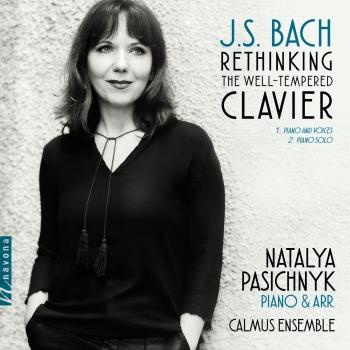Natalya Pasichnyk & Calmus Ensemble
Biography Natalya Pasichnyk & Calmus Ensemble
Natalya Pasichnyk
Ukrainian-born Natalya Pasichnyk, prize winner of several international piano competitions, has with Stockholm as her base, and with her deeply intellectual and creative interpretations, established herself as one of Europe’s leading concert pianists. Sweden’s biggest classical music journal OPUS magazine listed her twice (2014, 2022) as one of Sweden’s most influential cultural personalities. She has over the years also dedicated much energy on uncovering the unknown Ukrainian musical treasure for the Western audiences, and she has frequently appeared in both radio and TV.
Pasichnyk has performed widely throughout Europe, the United States, Japan, and Argentina, with leading orchestras such as the Swedish Radio Symphony Orchestra, Covent Garden Chamber Orchestra, Elbphilharmonie Laeiszhalle Hamburg, Orchester d’Auvergne, Lviv National Philharmonic Orchestra, Kraków Philharmonic Orchestra, and Poznań Philharmonic Orchestra, with such conductors as Christopher Hogwood, Evgeniy Svetlanov, Arie van Beck, Jacek Kaspszyk, Marek Mos, B Tommy Andersson, Robert Stehli, in major concert halls including Swedish Berwaldhallen and Konserthuset, Santory Hall (Tokyo), de Singel (Antwerp), Auditori Winterthur (Barcelona), Warsaw Philharmonic, Laeiszhalle (Hamburg), Teatro Colon (Buenos‐Aires).
Pasichnyk made numerous prize-winning recordings for companies such as BIS Records, NAXOS, OPUS 111, Pro Musica Camerata, Polmic, and Musicon. Consolation – forgotten treasures of the Ukrainian soul (BIS Records, 2017), with music by many unknown Ukrainian composers, quickly received very positive international attention and was described as the highlight of the year in German Mittelbayerische, with much critical acclaim from reviewers across the globe. In her recent recording Regamey & Regamey – Pasiecznik & Pasiecznik (2021), she introduces the listener to piano music by composers Regamey – the father who was killed by KGB and the son who emigrated to Switzerland.
Pasichnyk also holds the degrees Doctor of Arts and Doctor of Artistic Research.
Calmus Ensemble
A perfect blend of sound, precision, lightness, emotionality, and humoresque elements — these are the hallmarks of Calmus Ensemble, one of Germany’s most successful vocal groups. The wide range of tonal colors, the passionate joy the singers convey on stage, their sound culture, and their varied and imaginative programs never fail to inspire. With 50 to 60 concerts a year, Calmus is always a welcome guest throughout Europe and up to three times a year in the United States.
The ensemble’s repertoire is almost unlimited: Influenced by the tradition of the old masters of Leipzig, the singers are at home in the vocal music of the Renaissance, Baroque, and Romantic periods, but they are also interested in music of our own time. Over the years, they have commissioned and premiered numerous compositions, including works by Paul Moravec, Mathew Rosenblum, Bernd Franke, Steffen Schleiermacher, Wolfram Buchenberg, Bill Dobbins, Mia Makaroff, Dan Dediu, and Harald Banter. They also enjoy singing and arranging pop, folk, and jazz, as they published numerous sheet music publications.
Partnerships with colleagues such as MDR Sinfonieorchester (Weill’s The Seven Deadly Sins), the Raschèr Saxophone Quartet, the Hamburg Ratsmusik, the hr-Bigband, the Capella de la Torre or amarcord (Leipziger Disputation) further enrich Calmus’ repertoire, and the ensemble has already collaborated on two projects with the lautten compagney BERLIN (“BachArkaden” / “Mitten im Leben”). So far, the quintet has released more than 20 CDs and won several international prizes and competitions — most recently the OPUS KLASSIK 2019 for “Best Choral Recording.”
Part of their work is devoted to encouraging the up-and-coming generation, so workshops, masterclasses, and jury activities are part of their regular schedule, both at home in Leipzig and on their travels, e.g. as artists in residence at STIMMEN Festival Lörrach, Bachwoche Stuttgart, and also frequently in the United States.








